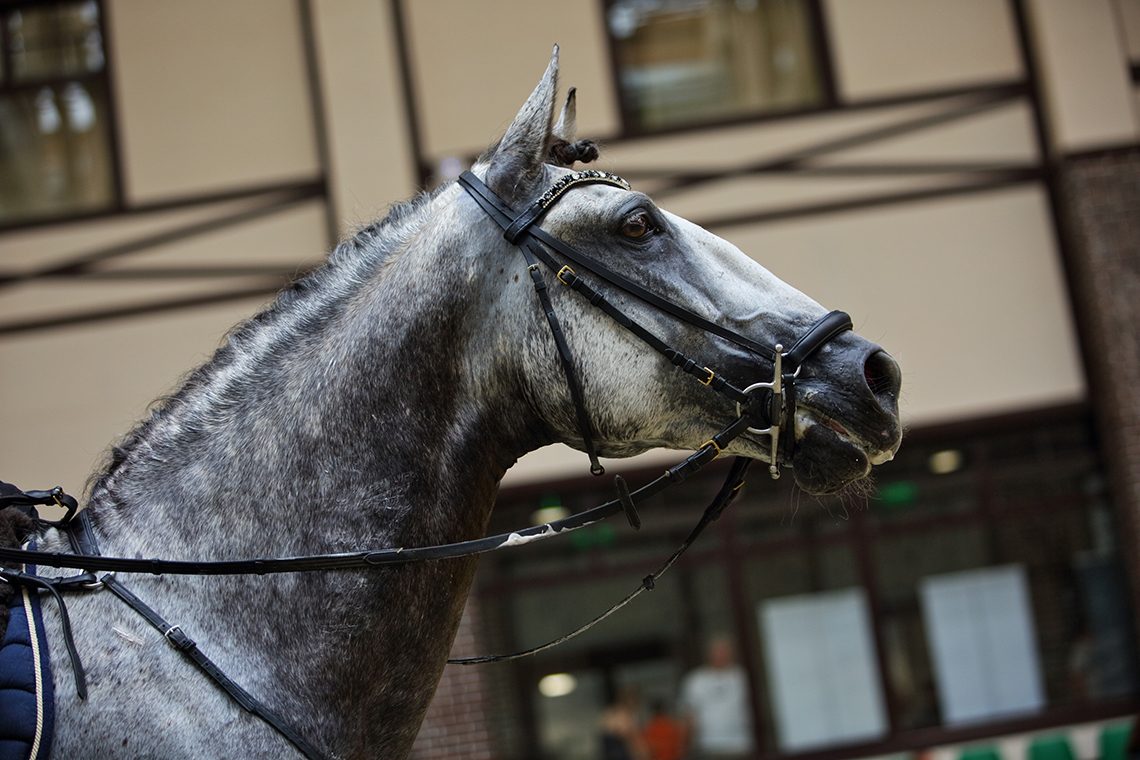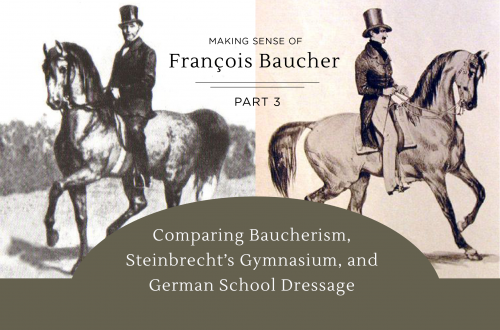
Why Aren’t Riding Stallions More Common in North America?
Learning to ride in the Pacific Northwest of Canada, there were very few stallions around. I remember meeting maybe four stallions in all the riding schools I ever visited, all of which were privately owned. Even today, stallions are quite uncommon in the average riding stable, and can sometimes be seen as unwelcome or complicated additions. Across North America, stallions appear far less popular among amateur riders when compared to places in Europe, such as in Spain and Portugal.
Why?
There are of course matters of convenience to consider – stallions sometimes need different living arrangements, and some can become calmer when gelded – which make it easier for many not to keep stallions. However, in some regions of the world stallions continue to be kept at a much higher rate without much inconvenience at all.
So what’s really causing the difference?
In my experience, there are crucial cultural differences that can play an underlying role in determining whether a culture is oriented towards keeping stallions or not. Among many factors (including available stabling, average handler skill levels, and convenience), cultural differences can determine how well typical handling and training in one culture meets the needs and priorities of stallions. This can then determine how well suited and effective the training will be for stallions, and thus how popular stallions will be for everyday riding work.
By learning to recognize and better address stallions’ needs and priorities ourselves, we can begin to strengthen our own training, and discover how wonderful working with stallions can be.
The Rarity of Riding Stallions in the United States
In 2007, a study on the Demographics of the U.S. Equine Population was released that described the average American riding horse in this way:
“In a random encounter with a member of the equine species in the United States, this is the most likely sighting throughout much of the country: a riding horse, standing about fifteen hands (sixty inches measured at the shoulders), either female (a mare) or neutered male (a gelding)—but certainly not a stallion.”
Emily Kilby, 2007. The Demographics of the U.S. Equine Population
This study, and a similar report by the USDA published in 2015, show that of all the horses in the U.S., approximately 49% are mares, 40% are geldings, and only about 8% are stallions.
This small proportion suggests that, as expected, in the U.S. and North America generally (as the U.S. represents the largest horse industry in NA), stallions are primarily used for breeding rather than riding.
Stallions Abroad
In contrast, when I went to learn classical dressage in Portugal, I keenly noticed that most of the riding horses were stallions! It also struck me that the stallions were much more straightforward to handle than I had been taught to expect. People in riding stables in the U.S. or Canada often view stallions as being difficult to handle, as being troublemakers, and as being potentially dangerous.
In some hands, this can absolutely be true. Some stallions can have a lot of energy, and are not suitable for some riders. However, this is not significantly different from the fact that not all horses are fit for all riders, whether it be geldings, mares, or stallions. And if you’re used to handling only geldings and mares, there are a few key things you must learn to do, like be crystal clear and definite about what you want and what’s acceptable.
However, stallions vary a great deal in temperament. Some stallions I’ve met were among the sweetest and most affectionate horses I’ve known. Horses like Dr. Peyo show us that there are stallions that are very calm, gentle, and affectionate (Dr. Peyo regularly visits and uplifts patients in hospitals). On the other hand, some stallions I’ve met have been extremely strong-minded and mission-focused. It depends. And when handled properly, stallions can be absolutely phenomenal, dedicated partners.
How could the perspective of stallions in North America have become so skewed?
Treating Horses as Partners versus Pets
While in Europe, I noticed that there was a significant difference between how people treated and viewed horses, and built their relationship with them. The riding cultures are distinctly different. In Portugal and Spain, horses are viewed more as partners, whether for recreation or for work. They are trained and expected to do a “job” together with their rider, such as to achieve training objectives.
In North America, on the other hand, another perspective is more common. Horses are often seen as pets or companions. In this case, riding can be much less structured than for the average rider in Spain or Portugal, and can be more focused on enjoying riding the horse as a pastime rather than workingthe horse in a systematic way. There are, of course, amateurs who also ride in a highly structured way. However, the average amateur North American rider seems to be less structured and strict with their horses, perhaps because they may more commonly seek relaxation and companionship with their horses than achieving goals in training.
In my experience, the former goal-oriented set of values more closely matches the needs and priorities of stallions. This could be part of the reason that stallions are so much more common in areas where these values are held, such as in Spain and Portugal.
Training Needs of Stallions
In general terms, stallions seem to do well when all their energy and interest can be engaged by helping their rider or handler pursue a clear goal. It seems that they like feeling that they play an important role. If there are no real, clear goals, or if there are no important and clear guidelines or expectations, stallions (like other horses with lots of energy) can start looking for more engaging and interesting things to do, which are not always the most desirable. This can result in behaviours such as them not paying attention, becoming overreactive when a request is then repeated more strongly, or trying out different behaviours (speeding up, biting, etc) to give themselves something interesting to do. In my experience, they like having a job, and feeling that they contribute in an important way.
This could be one reason why they become very good partners in riding cultures that see horses as partners for getting a “job” done, whether it be for recreation or for work. At the same time, this could be an underlying cultural reason why stallions are less popular among amateurs in North America, where the priorities are more about social connection and relaxation than about rigour and achievement. Without structure and a clear goal to motivate their energy and focus, stallions can start to develop a reputation for being unruly, which seems to be more often the case in North America.
Nevertheless,it should be noted that some stallions, regardless of their training, can be better off gelded and experience much better quality of life, as can the horses and handlers around them as a result. It’s not that stallions should always be kept intact, or that training can change everything. However, it’s important to recognize that where in some places there are systemic issues with stallions while in other places there are not, training can be the source of unruly behaviour. And in this case, it’s important to learn to recognize and better meet the needs of stallions in our training to help to create an environment wherein they can become content, motivated, and loyal partners.
Key Elements of Working with Stallions
As with any horse (or human or animal, really), it’s important to recognize and respect their needs and natural priorities. Where their needs for structure and having an important job aren’t met, they tend to disperse their energy and start engaging in potentially undesirable behaviours. This can create a reputation of them being unruly. However, by meeting their needs through improving ourselves and adapting our training, we can help to channel their energy in a positive way, and realize their potential. A few key things I’ve learned that can make a big difference with stallions are:
- Treating them as partners, and not as pets
Stallions often don’t seem much fulfilled by adoration alone. They like to feel that they play an important role and help fulfill important objectives through focused action. While stallions vary, generally they seem to do much better when they can engage in something rigorous.
Making riding or other activities more structured and goal-oriented with clear desired outcomes (in behaviour or training, for example) can help to engage their attention and energy and put it towards something of value. When stallions are engaged, they can be incredibly hard working and dedicated to doing things well. - Practicing confidence and decisiveness
Stallions often test their handlers. They want to know who is the most competent at making decisions to know who they can trust and look to for guidance. They want to follow handlers and riders who are confident, focused, and who make decisions with conviction. If their handler or rider doesn’t feel confident in their own choices or doesn’t stick to their decisions, why should they? If they sense a lot of doubt, indecision, or a lack of resolve, stallions (as well as other horses) may decide it’s not worth listening, which can lead to dangerous situations. This is why it’s very important to develop our own skill and confidence in ourselves, so that we can become trusted and competent leaders.
Deliberately practicing doing everything with a sense of sureness and focus, and sticking to decisions around stallions can make a big difference. - Showing respect for yourself, as well as them
Tying into the previous point, stallions look quite carefully at how we evaluate ourselves to determine how they should evaluate us. They sometimes cut less slack than mares or geldings. How you see yourself is very important. It tells them how to see you. If you don’t respect yourself – meaning, you allow things “just this one time” because you don’t want to say no or do something to stop it, or you allow things you aren’t comfortable with without saying or doing anything – stallions will often do what you allow. If something is not as you wanted, it’s your responsibility to tell them. This is how they reflect back as much respect as you have for yourself. This is also why it’s so important to notice what you’re allowing and correct it if necessary, as sometimes we aren’t even fully aware.
Practice correcting things immediately that you know aren’t quite right. For example, if you find yourself allowing the horse to inch forward without really correcting it, or to not engage as much as we know they can, or to come too close into your space, then ask them to step back, to engage properly, and to move and stay out of your space. This is as good for you as it is for the horse.
Respecting them is also important, and ties in with the first point about treating them as partners. Respecting a stallion includes respecting what means most to them. This means if the stallion doesn’t value affection, then focus on what does – meaningful work!
In Summary
By practicing these, I’ve seen a huge difference in my own relationships with stallions. Things flow much more easily and naturally. They read us very well, and in my experience as soon as we change ourselves and our training, they seem to shift immediately.
While many factors contribute to differences in the popularity of stallions in different regions, culture and training, I think, are key determinants. And despite their lack of popularity in North America, stallions can be truly wonderful partners. We must simply learn to recognize and respect their needs and priorities in our own work to bring out their full potential.




